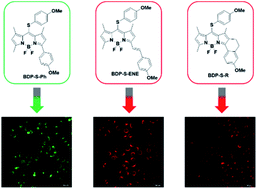Three asymmetric BODIPY derivatives as fluorescent probes for highly selective and sensitive detection of cysteine in living cells†
Abstract
Biothiols are widely involved in various important physiological activities and play a significant role in maintaining redox homeostasis in living organisms. Herein, we designed and synthesized three new asymmetric fluorescent probes (BDP-S-Ph, BDP-S-ENE and BDP-S-R) to discriminate Cys from Hcy/GSH. These probes reacted with Cys to form meso-amino-BODIPYs via SNAr substitution–rearrangement, thereby inducing a fluorescence turn-on effect. Moreover, they could selectively and sensitively detect Cys in solution with low detection limits (50 nM, 28 nM and 87 nM, respectively). Through comparing the response rates of the three probes to Cys, we concluded that the increase of conformational restrictions led to a decrease in probe reactivity. Besides, the sensing mechanism was demonstrated by mass spectrometry. Furthermore, cell experiments indicated that the probes were able to image exogenous and endogenous Cys through green or red channels in living cells.

- This article is part of the themed collection: Analytical Methods HOT Articles 2021


 Please wait while we load your content...
Please wait while we load your content...